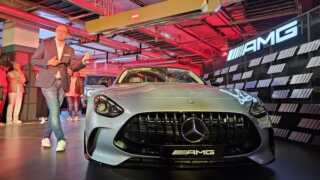By: Parth Charan
| Updated on: 18 Aug 2025, 13:12 pm Share via: Mercedes-Benz India MD Santosh Iyer talks about the recent surge in EV growth, Trump tariffs and the benefit of having Tesla enter the market. …Read More Mercedes-Benz India MD Santosh Iyer talks about the recent surge in EV growth, Trump tariffs and the benefit of having Tesla enter the market. View Personalised Offers on Check Offers Mercedes-Benz India MD Santosh Iyer is cautiously optimistic about India’s EV market penetration. Speaking at the recent launch of the CLE 53 AMG – a 449hp, straight-six petrol-powered sports coupè that’s the 10th AMG model in the brand’s India line-up – Iyer attributed the steady Y-o-Y growth of EVs to multiple reasons, including the availability of a wider range of models, and the expansion of retail touch points across the country. “Today, only 30% of India’s customer touch points sell EVs in any form. And that growth has happened from 10% so there are more customers who are educated about EVs now, and that’s driving growth”. EVs have seen wider acceptance in the luxury market, largely due to luxury EVs offering higher range, TCO that’s on par or less than ICE counterparts and the smooth and silent nature of the EV powertrain. “The luxury segment there’s 8-9% market penetration,” says Iyer, while refraining from speculating what the luxury EV market penetration would be by 2030. “We don’t want to put a number or a target in terms of projected market penetration by 2030. All we can say is that we’re committed to EVs. From Maybach to AMG – All have an EV powertrain in their portfolio. Ultimately, it’s the market, regulatory framework and customer that set the pace of transformation,” says Iyer. “The first cycle of EV ownership needs to complete for more customers to gain confidence” On the arrival of TeslaMercedes-Benz India – one of the leading players in the luxury EV space remains unfazed by Tesla’s arrival. “The price point at which Tesla operates, we operate in single digits in the segment, as our sales predominantly come from the above ₹60 lakh segment. It goes all the way up to ₹7-8 crore, so we feel insulated”. “Many of our customers might opt for Tesla as a second or third car, but it won’t cannibalise our sales. Not from a volume perspective,” admits Iyer, owing to the novelty that the American EV maker is currently enjoying. Iyer also admits that while Tesla’s current mode of operation (via the CBU route) will not enrich the local EV supply chain in any significant way, it does help boost the image of EVs. “I feel like, even with two outlets, you have so many people coming and checking out the Teslas. It goes a long way in helping people understand EVs and for EVs to gain their confidence” On ethanol blendingWith public sentiment around car ownership souring due to the government’s new E20 fuel mandate, Iyer feels that the luxury segment remains relatively unaffected as most luxury brands, Mercedes-Benz included, brought E20 compatibility to their entire portfolio before the mandate was set in motion. “The mass market segment is highly price sensitive, so carmakers engineer a car for the need of the day, whereas the luxury segment, you can engineer it for tomorrow” However, public concern remains not only around the current blend of petrol but also the notion that meeting further blending targets of E27 could affect sales of ICE vehicles, closer to 2030. Iyer, however, remains dismissive of the notion. “I think policymakers are clear that E20 is the max and anything more than that will be implemented in a selective manner. E100, for instance, cannot happen from a technical standpoint”. Iyer’s statement came a day before Union Road Transport and Highway Minister Nitin Gadkari announced that the future of fuel will be 100% ethanol. The Central government, however, hasn’t announced any clear roadmap towards E27 level blending, at the moment. “Even before we had introduced a BSVI-compliant fleet, we had engineered our cars for a lower fuel rating,” says Iyer, adding that the government had been very clear about implementing a 20% ethanol blend in petrol sold across the nation. “Everybody knows that E20 is coming up. Did everyone engineer their cars based on that requirement? The answer may be no. On Mercedes-Benz becoming a more integral part of the global supply chainWhen asked if the brand is in any way affected by the US tariffs, Iyer remained optimistic. “I think the tariff situation can be viewed both ways. I would say on one side we have the US tariffs, but there are also positive outcomes. India is actively discussing an FTA with Europe. We have an FTA with the UK, Australia, and the Middle East (UAE). If you look at the opportunity there, that’s bigger” “There’s a lot of noise about the prices of cars being imported, but I’d say the bigger opportunity is for exporting components to other markets. Because India’s component ecosystem is very mature and capable. We need to see what’s required for us to localise in India. For instance, in the E-Class, all the glass components on the vehicle are localised”. Does this mean Mercedes-Benz India intends to export components like it has done in the past, along with models like the locally built GLC, which was briefly being exported to markets like the US? “Our plant is built for India and dedicated to India; that’s the manufacturing set-up. Our focus is not on exports. We are designed to cater to local requirements” (Parth Charan is an independent automotive journalist and writer who has written on cars, motorcycles and the automotive industry for the past 12 years. He lives in Mumbai.) Check out Upcoming Cars in India 2025, Best SUVs in India. First Published Date: 18 Aug 2025, 13:12 pm IST
Source: hindustantimes.com






